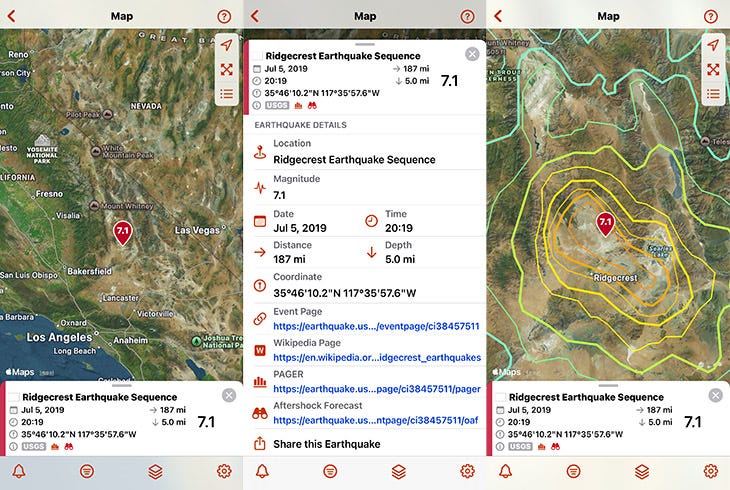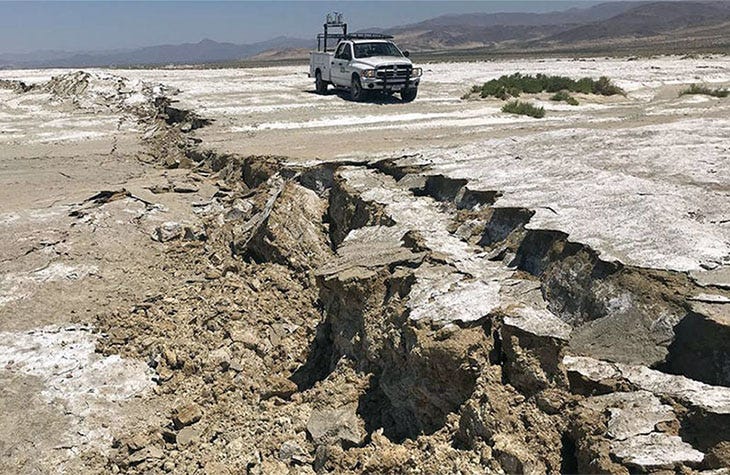2019 Ridgecrest Earthquake Sequence
A powerful one-two punch that rattled Southern California on July 4th and 5th, 2019.
On July 4, 2019, a magnitude 6.4 earthquake struck near Ridgecrest in California’s Mojave Desert. Thirty-four hours later, it was followed by a magnitude 7.1 mainshock—the largest earthquake to hit California in 20 years. The earlier quake was later identified as a foreshock to this larger event.
Maps from the QuakeFeed app, showing the epicenter, earthquake details, and the shaking intensity for the July 4, 2019 M6.4 foreshock.
Basic Facts - M6.4 Foreshock
Location: 11 miles ENE of Ridgecrest, California (approximately 110 miles northeast of Los Angeles)
Date & Time: July 4, 2019 at 10:33 a.m. PDT (17:33 UTC)
Magnitude: 6.4 Mw
Depth: 6.6 miles (10.7 km) Shallow strike-slip mechanism
Fault System: Salt Wells Valley Fault Zone intersecting with Little Lake Fault Zone
Maximum Intensity: VII (Very Strong) on the Modified Mercalli Intensity Scale
Felt Area/Population Affected: Felt by approximately 20 million people from Sacramento to Phoenix and south to Baja California, Mexico
Tectonic Setting: Eastern California Shear Zone (ECSZ)
Maps from the QuakeFeed app, showing the July 5, 2019 M7.1 mainshock of the 2019 Ridgecrest Earthquake Sequence, earthquake details, and shaking intensity.
Basic Facts – M7.1 Mainshock
Location: 11 miles north of Ridgecrest, California (approximately 125 miles northeast of Los Angeles)
Date & Time: July 5, 2019 at 8:19 p.m. PDT (03:19 UTC July 6)
Magnitude: 7.1 Mw
Depth: 5 miles (8 km) Shallow strike-slip mechanism
Fault System: Little Lake Fault Zone and Airport Lake Fault Zone intersection
Maximum Intensity: IX (Violent) on the Modified Mercalli Intensity Scale
Felt Area/Population Affected: Felt by approximately 30 million people across Southern California, parts of Arizona and Nevada
Tectonic Setting: Eastern California Shear Zone (ECSZ)
Impact Summary
The 2019 Ridgecrest earthquake sequence struck Southern California over two consecutive days in early July, beginning with a magnitude 6.4 foreshock on July 4 at 10:33 a.m. PDT. This was followed by the more powerful magnitude 7.1 mainshock on July 5 at 8:19 p.m. PDT – the largest earthquake to hit Southern California in two decades.
The seismic activity generated intense shaking that was felt across much of Southern California and extended into parts of Arizona and Nevada. The earthquakes claimed one life and injured 25 people. The fatality occurred in Pahrump, Nevada, more than 150 miles from the epicenter, when a vehicle supported by jack stands collapsed onto a man working underneath it.
The 2019 Ridgecrest earthquakes left pronounced scars across the Mojave Desert, with cracks in the earth stretching approximately 30 miles. These surface ruptures were clearly visible — shifting the ground by more than six feet in places.
The economic impact was substantial, with total damages estimated at more than $5.3 billion. China Lake Naval Air Weapons Station sustained the most severe damage, with repair costs estimated at $5.2 billion and about 20 percent of its buildings declared unsafe. The civilian communities of Ridgecrest and Trona also experienced structural damage, fires, and infrastructure disruptions, though to a lesser extent. Approximately 3,000 residents lost electrical power, and several roads were damaged or blocked by rockslides.
Surface rupture from the 2019 Ridgecrest earthquake. These visible ground breaks help scientists study fault behavior and earthquake mechanics. Photo credit: Ben Brooks/USGS
Notable Facts
1. Surface rupture: Because the Ridgecrest earthquakes struck in a remote desert area with little vegetation or development, scientists were able to map the surface rupture in remarkable detail using drones, satellite radar, and on-the-ground surveys. The clear view of how the land broke apart gave researchers insight into the complex fault system beneath the surface.
2. Unprecedented aftershock activity: The 2019 Ridgecrest earthquakes set off an unusually large and long-lasting swarm of aftershocks. Geologists at the USGS estimated that more than 34,000 aftershocks happened in the first six months following the earthquakes.
Scientific Significance
The 2019 Ridgecrest earthquake sequence demonstrated an unusual pattern: the magnitude 6.4 foreshock and magnitude 7.1 mainshock occurred on two different fault systems. The foreshock struck a northeast-trending left-lateral fault, while the mainshock ruptured a northwest-trending fault with right-lateral motion. This "segment-jumping" behavior led scientists to investigate how earthquakes can trigger each other across different fault systems.
Underground, the foreshock created an "L-shaped" rupture pattern that affected both fault systems simultaneously, even though surface breaking was initially visible on only one fault. Stress changes from the first earthquake systematically increased pressure on the second fault, essentially loading it toward failure and setting the stage for the larger mainshock.
Beyond the main earthquakes, the sequence generated an extraordinary aftershock response that began immediately after the foreshock on July 4 and intensified dramatically following the mainshock on July 5. This intense seismic activity continued for many months, with the sheer volume and frequency of events sometimes overwhelming local monitoring networks. While many aftershocks were too small to be felt, dozens reached magnitude 4.0 or greater, and some caused additional damage to structures already weakened by the main earthquakes.
QuakeFeed map from July 7, 2019, showing ~4,000 Ridgecrest aftershocks. The larger earthquakes are shown in red and smaller ones in yellow. The distinct perpendicular pattern reveals how the earthquakes activated two intersecting fault systems.
The Ridgecrest sequence has become an important case study for understanding earthquake cascades and stress transfer between intersecting fault systems. For scientists, this provided an excellent opportunity to observe how stress redistributes across a complex fault network in real time, offering valuable insights into earthquake mechanics and fault interactions. These findings suggest that seismic hazard assessments should consider not just individual faults, but the potential for earthquakes to propagate through connected fault networks in tectonically active regions.
Get the QuakeFeed App
Curious about historical earthquakes? Download QuakeFeed from the iOS App Store to explore thousands of earthquake events on an interactive map. Activate the 30-day Free Trial for QuakeFeed Premium to view the historical earthquakes.
View the 2019 Earthquake Sequence in QuakeFeed
Open QuakeFeed and tap the Data Source button (second from left).
Tap Earthquake Source and Filters at the top.
Select Change Data Source → USGS Historical
Select USGS Since 1900, U.S. Lower 48.
Tap Next → Finish → Done.
In the search box, type Ridgecrest.
Tap on one of the Ridgecrest Earthquake events to view it on the interactive map.
Pull up the details panel for links to the USGS event page, Wikipedia, and more.
Tap the Map Settings button (third from left) to add layers like Faults and MMI Contours.
Continue Learning
USGS Event Page: M 6.4 - Ridgecrest Earthquake Sequence
USGS Event Page: M 7.1 - Ridgecrest Earthquake Sequence
Wikipedia: 2019 Ridgecrest earthquakes
QuakeFeed Podcast: 2019 Ridgecrest Earthquake Sequence
IRIS (VIDEO): Ridgecrest Foreshocks, Mainshock, Aftershocks July 4-10
USGS (VIDEO): ShakeMovie of M6.4 Ridgecrest Earthquake
USGS (VIDEO): ShakeMovie of M7.1 Ridgecrest Earthquake
Be Prepared
Anniversaries of major events like the 2019 Ridgecrest Earthquake Sequence remind us of the importance of earthquake preparedness. Use this anniversary to refresh your emergency supplies and review your family's safety plan. Earthquakes may be unpredictable, but your response doesn't have to be.







My husband & I were at a restaurant near Phoenix, AZ when it happened. The lights in the restaurant started swinging and I felt dizzy. I got a video. We were about 300 miles from the epicenter. Thanks for this informational article.
I like it so much but I’m learning. By the way, I don’t have it my iPhone and just my iPad and computer too